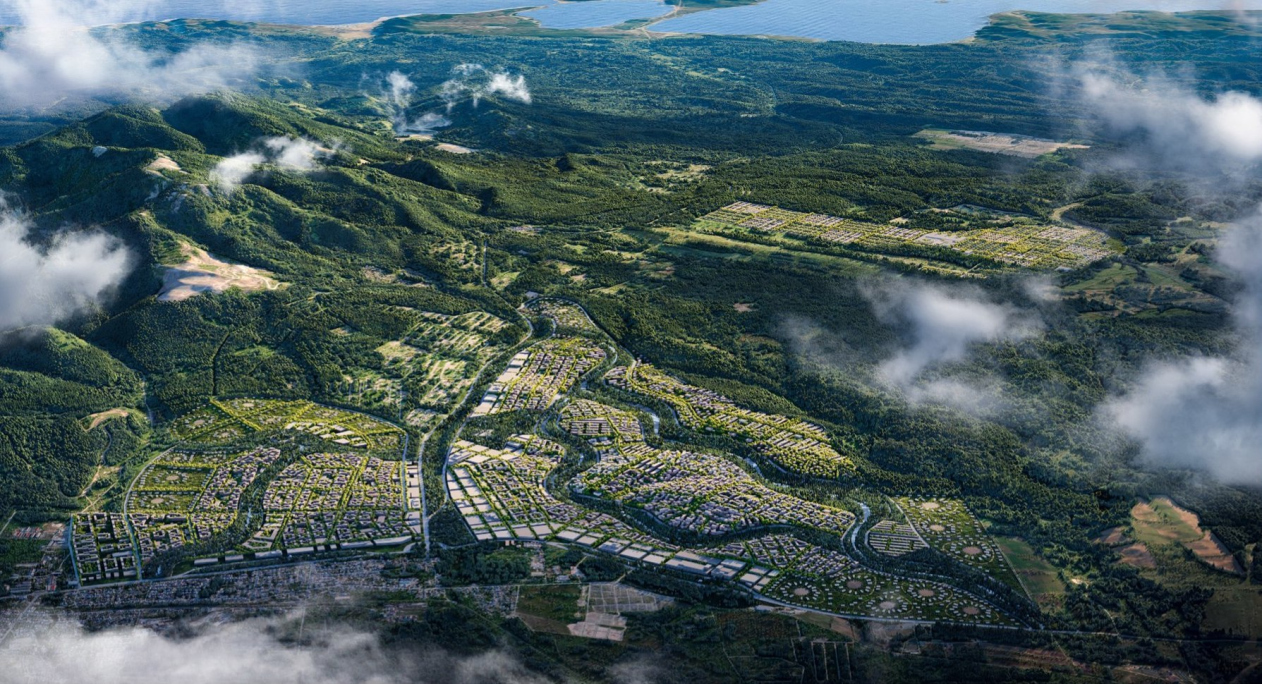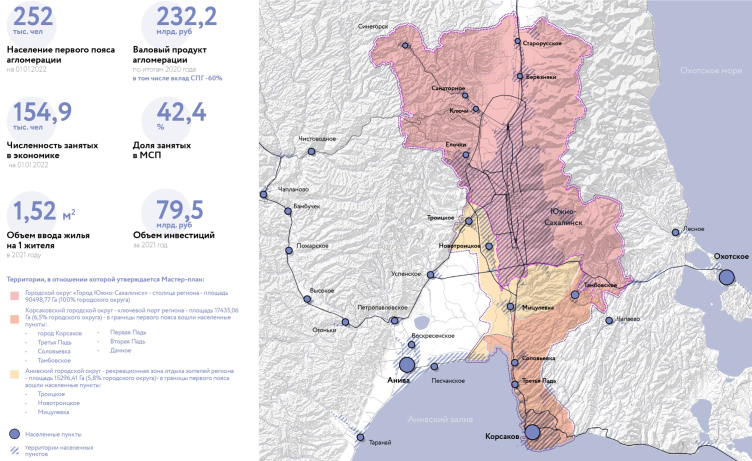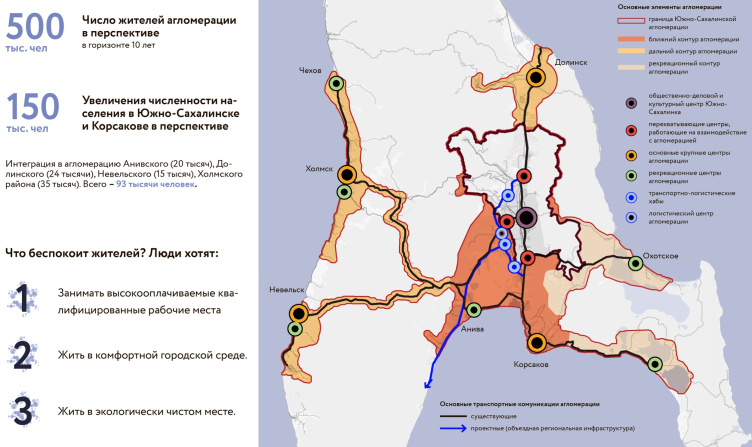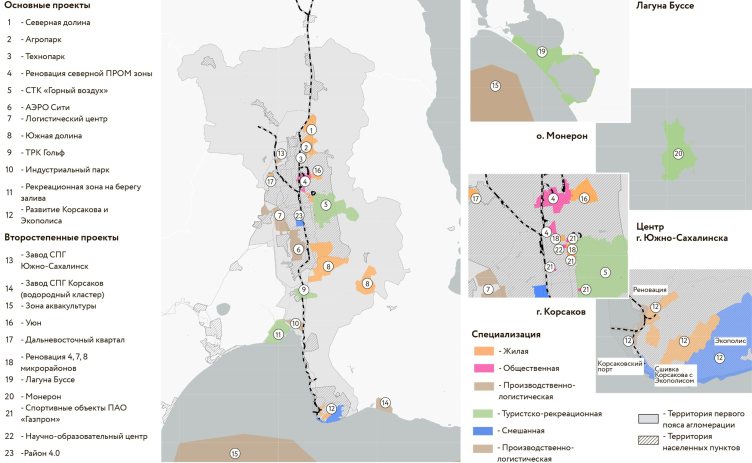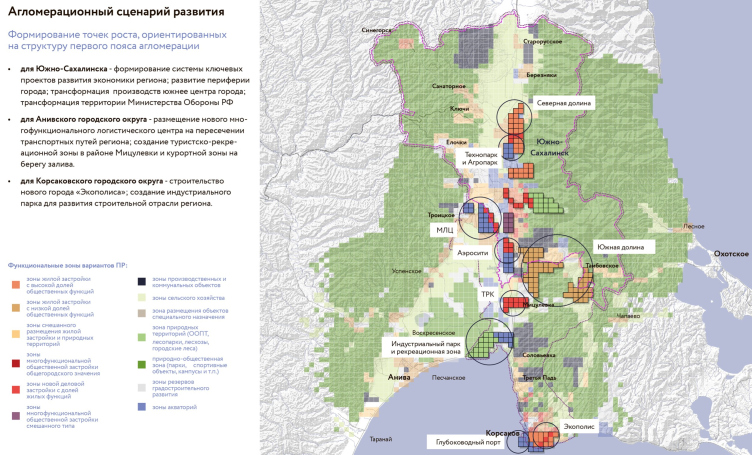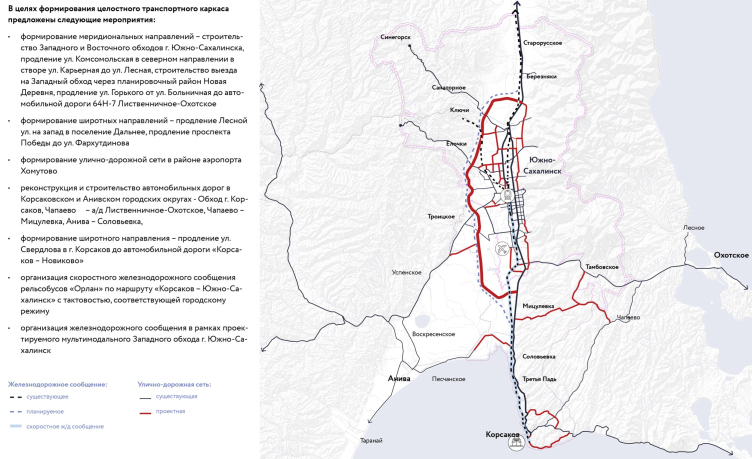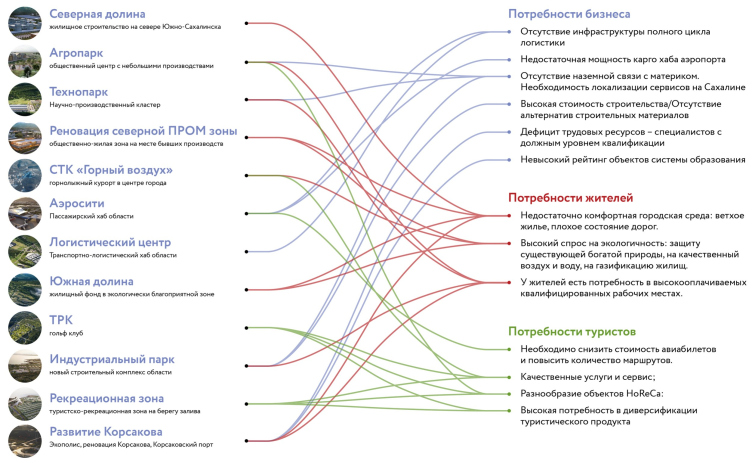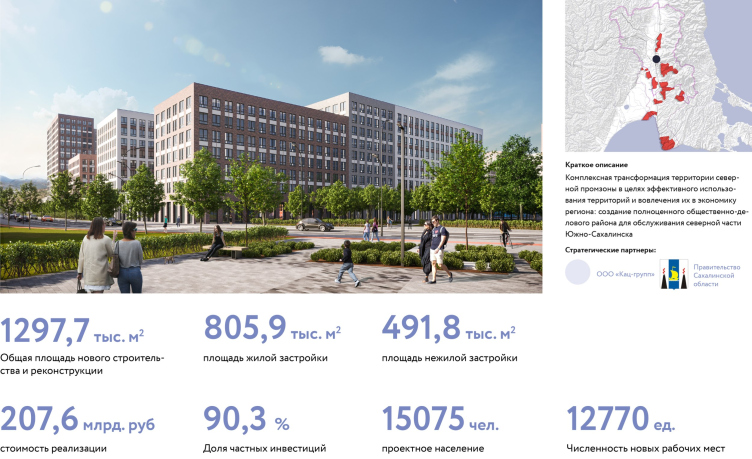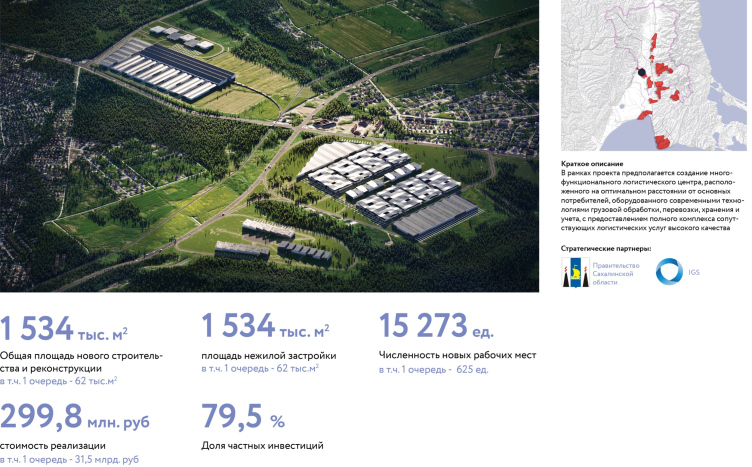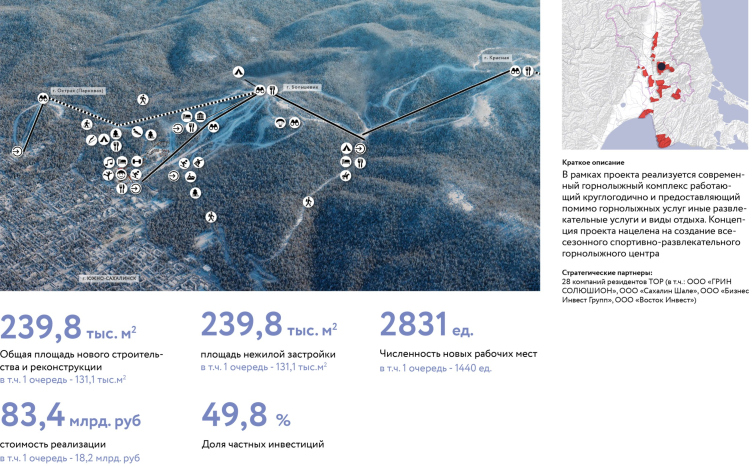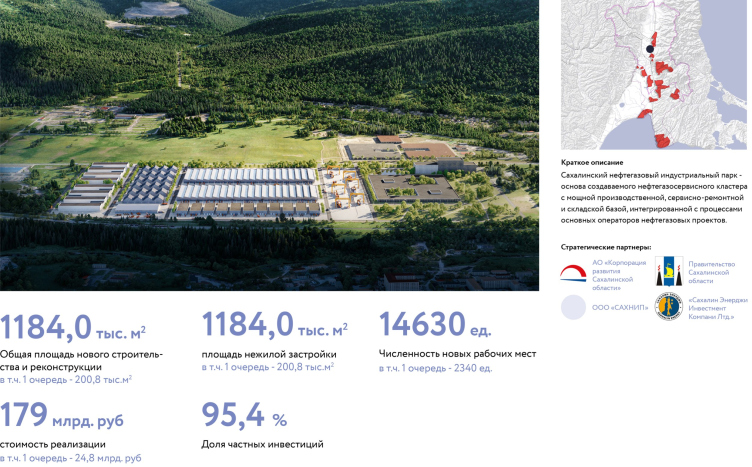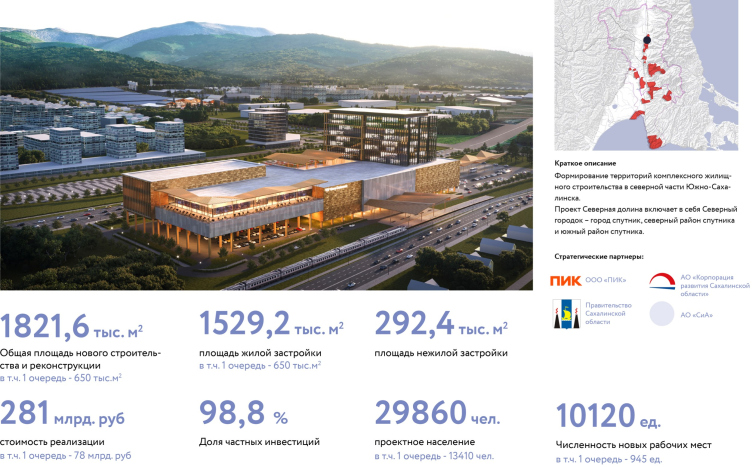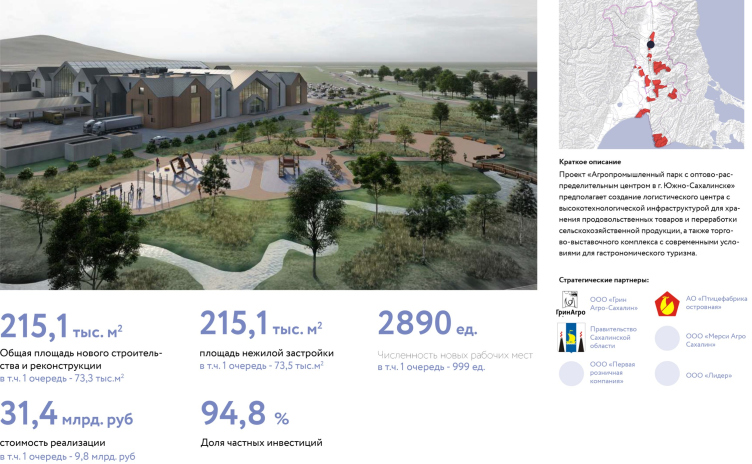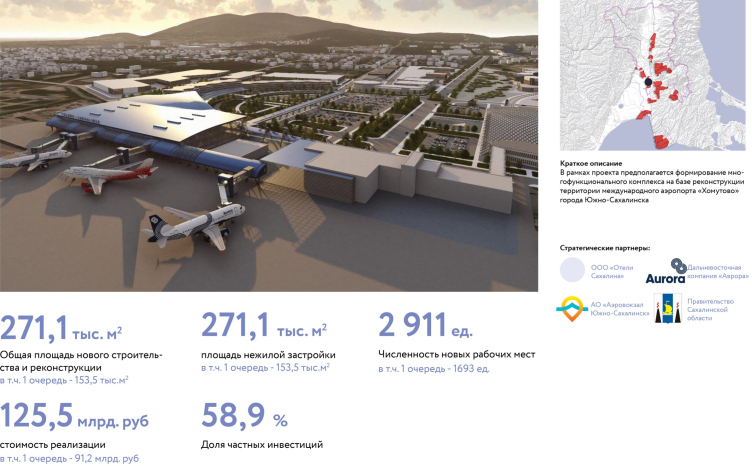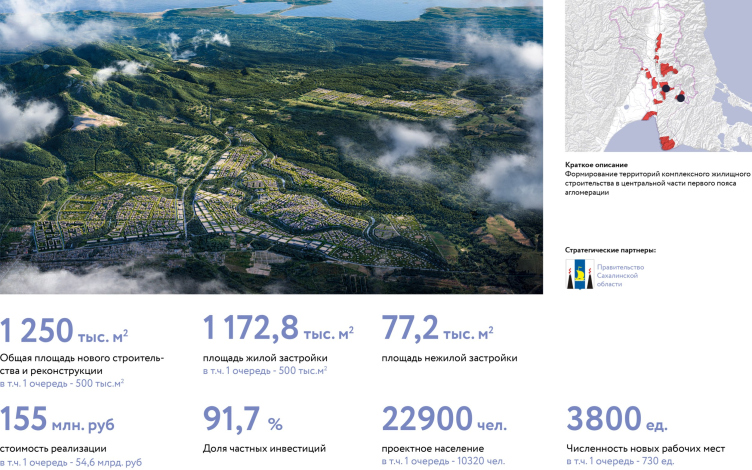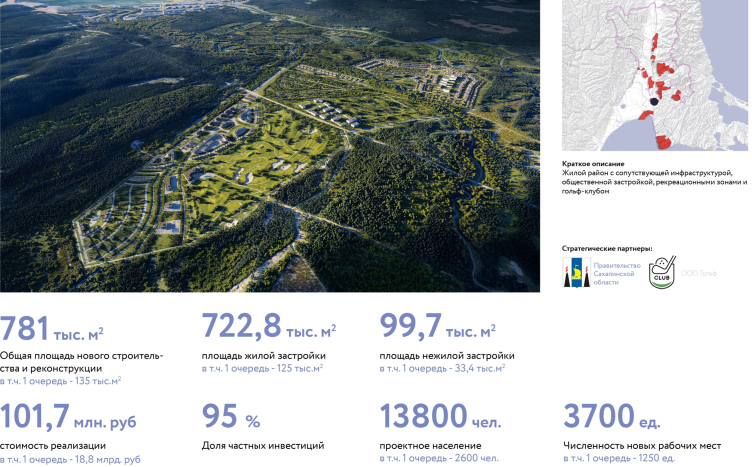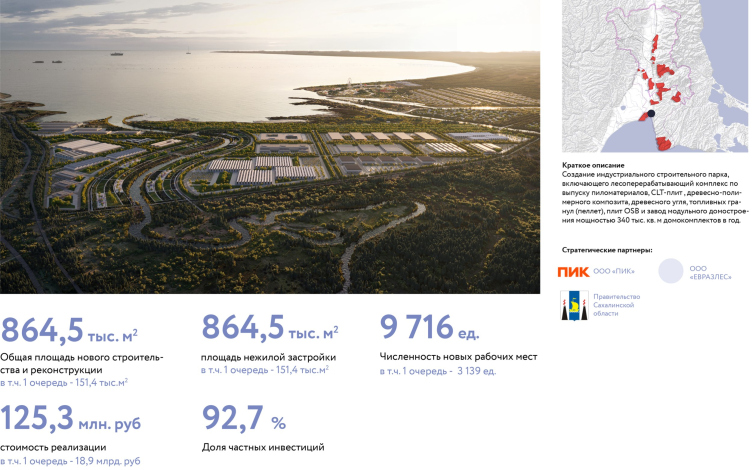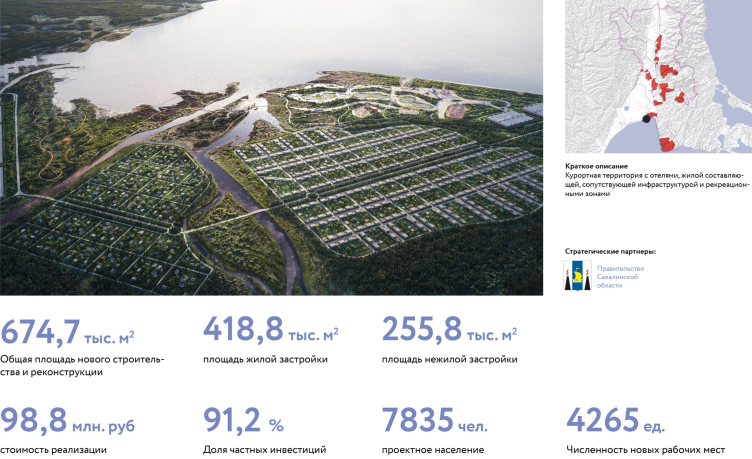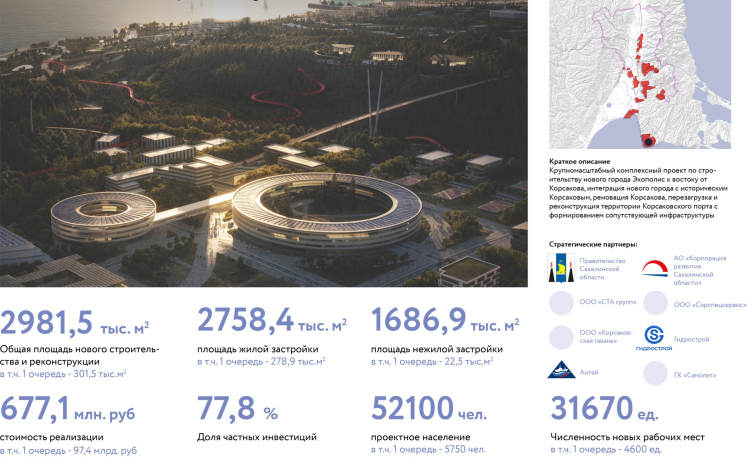The Genplan Institute of Moscow has been working with the city for a long and fruitful time – since 2016; it developed a package of documents for it, the most important of them being the master plan approved in 2021. The situation looks paradoxical, but the team explains that there is no contradiction: the new master plan is fully consistent with the original one, it uses its developments and solutions, but has slightly different goals – primarily to outline and justify the economic development strategy. In addition, the new master plan covers a larger territory – for example, the city of Korsakov, located 30 km to the south on the shore of Aniva Bay.
The consortium headed by the Institute includes Knight Frank – a strategic partner, one of the major players on the market of commercial and high-end residential real estate in Russia. Another member is IND Architects, whose presence also makes perfect sense, since the concept of this team won the competition for the creation of the new model of Korsakov “Ecopolis”. The economic model was supervised by Anton Zaitsev, deputy chairman of the government of the Sakhalin region.
The company called Marta made a package of high-quality visualizations and an interactive map for the Eastern Economic Forum, as well as 3D visualizations for a promo video, which was directed by Yulia Nemova. Watching it makes you want to buy a ticket to the other side of the world, which will soon become economically self-sufficient. On a more serious note, the video reveals the essence of the 300-page album with the materials of the master plan in a very accessible and comprehensible manner.
Acupuncture for Growth
The main thing that distinguishes the new master plan is the macro-processes and the emphasis on the investment component. The economic model is built based on the unique features of the region and mathematical calculations. The planning horizon is about ten years.
Master Plan of the first belt of the Yuzhno-Sakhalinsk agglomeration. Agglomeration structure
Copyright: © Genplan Institute of Moscow, IND Architects, Knight Frank
The features of Yuzhno-Sakhalinsk look quite promising. Its favorable location in relation to the key markets of the Asia-Pacific region suggests integrating it into the Northern Sea Route, the shortest route from Asia to Europe. Outside the agglomeration, in the north of the island, oil, gas and coal are extracted and refined – these resources need no additional introduction. Numerous natural riches promise a year-round inflow of tourists – lovers of mountain skiing, diving and spectacular views. The fishing industry cannot be neglected either.
After calculating several options, the Institute chose the “Energy and Economic Center of the Far East and APR” scenario for Yuzhno-Sakhalinsk and identified 12 points of growth. The well-balanced placement of these 12 clusters will provide a qualitative leap in the development of the entire Sakhalin Oblast, creating high-paying jobs, as well as a comfortable urban environment and housing. It is expected that the implementation of the solutions laid down in the master plan will increase annual GRP growth to 5.4% per year by 2030 and to 6.2% in the long term.
Master Plan of the first belt of the Yuzhno-Sakhalinsk agglomeration. A Space of New Opportunities in a Region with Advanced Technology
Copyright: © Genplan Institute of Moscow, IND Architects, Knight Frank
From South to North
When talking about the development of Yuzhno-Sakhalinsk, one cannot ignore its critically important feature – the linear layout conditioned by its relief: the city is located in a valley and is flanked on both sides by mountain ranges that restrain extensive development. Since expansion is only possible in two directions – northward and southward – in past historical periods industrial and agricultural lands have grown around the urbanized urban core; this way, a chain of poorly connected spaces has been formed.
The Institute proposes to meet this challenge by developing public transport and alternating residential areas and large economic clusters within 15 minutes of each other. For this purpose, new areas are involved in the development, and the old ones are functionally saturated. The elaboration of heat maps and big data from the general plan made it possible to determine the points that need to be added to these or those facilities.
Master Plan of the first belt of the Yuzhno-Sakhalinsk agglomeration. Specialization of strategic and secondary projects of the agglomeration
Copyright: © Genplan Institute of Moscow, IND Architects, Knight Frank
Master Plan of the first belt of the Yuzhno-Sakhalinsk agglomeration. Variant of the concept #2. Brief description
Copyright: © Genplan Institute of Moscow, IND Architects, Knight Frank
Transportation
Yuzhno-Sakhalinsk, like the rest of the island, is one of the leaders in motorization, but the authors of the master plan rely on the development of public transportation. The existing railroad line is planned to be modernized and equipped with new stations. The north-south connection will be strengthened by the subway line (Bus Rapid Transit), as well as by the branching of transverse links in the framework of the street and road network. Polycentricity, a large number of stops, convenient interchange hubs and bicycle infrastructure in the complex will allow to implement the ideology of a “15-minute city” – that is how long it takes to get to any point from any other point.
To make the agglomeration’s system of logistics routes still more efficient, it is necessary to build the western and eastern bypass highways. They will make it possible to move cargo flows outside the old and new centers of Yuzhno-Sakhalinsk.
The axis for the new clusters is now the railroad line that runs through the entire city and connects it to the airport, Korsakovo, and the sea port.
The Power of Twelve
The main result of the master plan are investment passports for 12 development clusters: almost all of them involve new construction. The four key areas are logistics, oil refining, agricultural self-sufficiency, and recreation. In addition, it is planned that the island will develop its own construction complex, which will make the island less dependent on the mainland and accelerate the implementation of various projects.
Below, we will share about each of the clusters in more detail.
Master Plan of the first belt of the Yuzhno-Sakhalinsk agglomeration. Variant of the concept #2. Scenario of the agglomeration, transport
Copyright: © Genplan Institute of Moscow, IND Architects, Knight Frank
The New City Center
The territories adjacent to the current center of the city will be cleared from inefficient industries, which will pave the way for the city’s growth. The architects make a clear analogy: “The renovation project pulls the cork out of the bottle and allows the urban center to grow further, merging with the residential areas on the periphery”.
The new belt of the city center consists of neighborhoods associated with Chinese, Korean, and Japanese culture. Its function is mixed: offices, recreation, trade, culture, entertainment, and technology parks are interspersed with housing. This model, as the architects explain, is popular for the master plans of Far Eastern cities and is attractive to investors as well. It gives the residents an opportunity to use services that are not available on our market.
Master Plan of the first belt of the Yuzhno-Sakhalinsk agglomeration. Key projects – answers to development challenges
Copyright: © Genplan Institute of Moscow, IND Architects, Knight Frank
The logistics center is located in optimal proximity to the railroad, the aerocity, and the bypass road. The relocation of industrial sites to the periphery, where the accompanying logistics infrastructure is growing, will relieve the “middle” part of the city of trucks.
Master plan of the first belt of the Yuzhno-Sakhalinsk agglomeration. Project passport – Northern Industrial Zone
Copyright: © Genplan Institute of Moscow, IND Architects, Knight Frank
The already-existing mountain resort “Gorny Vozdukh” (“Mountain Air”) is located closer to the city center and is already an important public space – it will be expanded and developed further.
Master Plan of the first belt of the Yuzhno-Sakhalinsk agglomeration. ILC Project Passport
Copyright: © Genplan Institute of Moscow, IND Architects, Knight Frank
North of the Center
The oil and gas industrial park is focused on increasing the self-sufficiency of the oil industry in the region, which in turn will increase its efficiency.
Master Plan of the first belt of the Yuzhno-Sakhalinsk agglomeration. Project Passport – Gorny Vozdukh mountain resort
Copyright: © Genplan Institute of Moscow, IND Architects, Knight Frank
The Northern Valley residential area is formed around new economic clusters, so that people live near their jobs and do not waste time and resources on commuting. We have already told you about one of the projects of this cluster, the Uyun Park complex.
Master plan of the first belt of the Yuzhno-Sakhalinsk agglomeration. Project passport – Technopark
Copyright: © Genplan Institute of Moscow, IND Architects, Knight Frank
The agricultural park will divide the “Northern Valley” into two parts. The cluster is designed to increase the food security of the region and provide the population with fresh, inexpensive products, many of which are now brought in from the mainland, which increases their cost manifold. The agropark will become a point of distribution of products produced on the island, and a shopping center with an agricultural bias.
Master plan of the first belt of the Yuzhno-Sakhalinsk agglomeration. Project passport – Northern Valley
Copyright: © Genplan Institute of Moscow, IND Architects, Knight Frank
South of the Center
The reconstruction of the Khomutovo airport and the creation of the Aerocity cluster with a logistics site and public facilities should contribute to greater accessibility to the island.
Master plan of the first belt of the Yuzhno-Sakhalinsk agglomeration. Project passport – Agricultural Park
Copyright: © Genplan Institute of Moscow, IND Architects, Knight Frank
The Yuzhnaya Dolina cluster involves low- and mid-rise development typical of the suburban lifestyle. The environment is saturated with necessary infrastructure and public facilities, which include an educational campus.
Master plan of the first belt of the Yuzhno-Sakhalinsk agglomeration. Project passport – Aerocity
Copyright: © Genplan Institute of Moscow, IND Architects, Knight Frank
The tourist and recreational complex is located three kilometers away from the southern boundary of the city and includes both recreational areas and residential development. The anchor facility here is a golf club.
Master plan of the first belt of the Yuzhno-Sakhalinsk agglomeration. Project passport – South Valley
Copyright: © Genplan Institute of Moscow, IND Architects, Knight Frank
An industrial construction park is located near the Salmon Bay, including a timber processing complex for the production of lumber and CLT plates, as well as a modular house-building plant. It will optimize the production chain of construction on the island.
Мастер-план первого пояса Южно-Сахалинской агломерации. Паспорт проекта – ТРК
Copyright: © Genplan Institute of Moscow, IND Architects, Knight Frank
A large recreational area with an amusement park will appear on the embankments of Aniva Bay. The system of quays will be used to launch a cruise route between tourist attractions – Busse Lagoon, which was recently included in the top ten tourist and recreational complexes in the ASI contest, and Moneron Island, which is famous for its diving conditions.
Master plan of the first belt of the Yuzhno-Sakhalinsk agglomeration. Project passport – Industrial Park
Copyright: © Genplan Institute of Moscow, IND Architects, Knight Frank
Korsakov
The master plan provides for the gradual merging of Yuzhno-Sakhalinsk and Korsakov, the two largest cities on the island. After dredging, the port of Korsakov will become the “southern gateway” to the Northern Sea Route, and the agglomeration will become a global logistics hub, as the railroad will eventually extend to the mainland. The master plan also includes the construction of a fish processing plant, a refrigerating plant, an increase in the production of small ships and the turnover of a new container terminal.
The city will expand through the “Ecopolis” district, which will include scientific and educational centers.
Master plan of the first belt of the Yuzhno-Sakhalinsk agglomeration. Project passport – Recreational area
Copyright: © Genplan Institute of Moscow, IND Architects, Knight Frank
***
The plan of complex development of Yuzhno-Sakhalinsk agglomeration was approved for the period till 2030. Among the priorities are the reconstruction of the port of Korsakov, the modernization of the airport, the construction of roads, and the creation of an innovative educational complex.
Master plan of the first belt of the Yuzhno-Sakhalinsk agglomeration. Project passport – Korsakov
Copyright: © Genplan Institute of Moscow, IND Architects, Knight Frank

